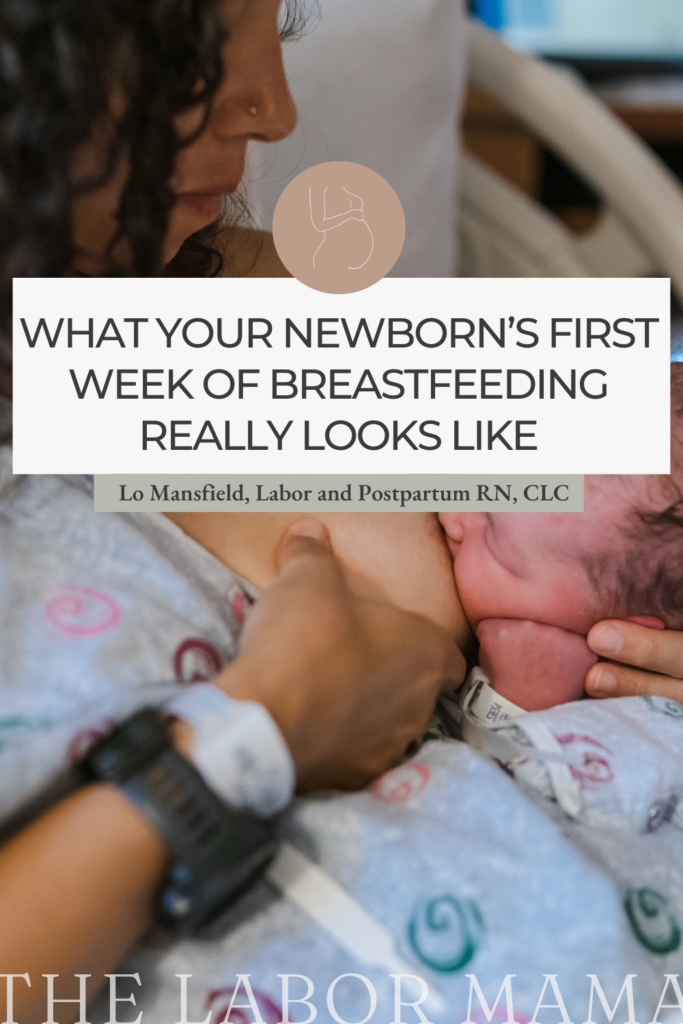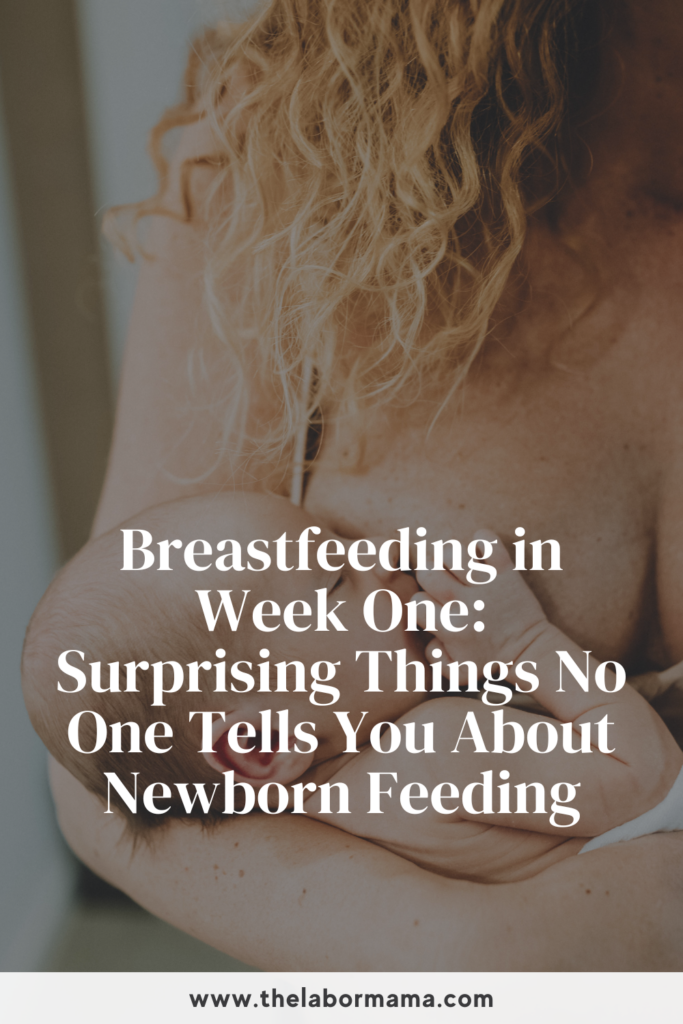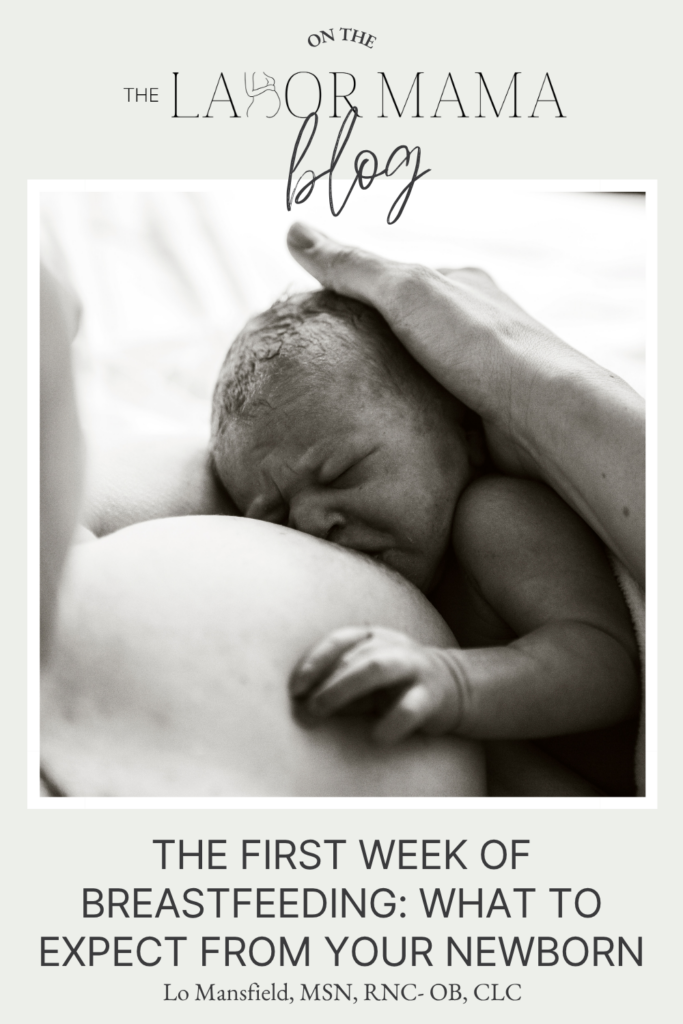If you’re preparing to breastfeed (or already navigating those first few days), it can be reassuring to know what’s normal. While every baby and body is different, there are a few feeding patterns that show up again and again in the first week of life (as well as ways to help you establish milk supply, make sure you give that a read if you haven’t or download my free Milk Supply 101 guide here). Understanding these rhythms with the first week of breastfeeding ahead of time can take some of the mystery—and stress—out of those early newborn days.
Let’s walk through what often happens with newborn feeding in the first week, starting right after that very first feed.
Who is The Labor Mama and Why Am I Here?
Hey friend! I’m Lo – also known around here and social media as The Labor Mama. I’ve spent my nursing career in labor, delivery, and postpartum, have birthed 4 of my own babies, have labored thousands of mamas at the bedside, have taught hundreds of students online, and have even delivered a few speedy little babies with my bare hands (oops).
Here at TLM, I offer online classes to empower you the way everyone should be. The education + support I offer gives you experience, evidence, and empathy; you’re getting all of my years of “clinical” RN knowledge, beautifully combined with my real experiences as a mama and a nurse. These are not your average hospital classes (those won’t do it, I promise), and honestly, birth, postpartum, and breastfeeding don’t follow a textbook or protocol anyway. You need to know so much more than that!
If you want to connect with me further, head to Instagram. There are hundreds of thousands of us over there learning together daily.
A note: This post may include affiliate links. This means if you make a purchase after clicking a link, I will earn a small commission (thank you)! Rest assured, this comes at no additional cost to you. You can read TLM’s full disclosure here.
Newborn Feeding Patterns in the First Week
I’m gonna be honest – as you read thought these different possibilities during the first days, my guess is you may have even more questions, like:
- How do I wake a sleepy baby?
- How my sleep is too much sleep?
- Is my baby colicky?
- How do I know I’m making enough milk?
- When will my milk come in?
- How do I know my baby is getting enough milk?
- What if our latch isn’t working
- And so many more…
And the truth is, breastfeeding is a puzzle sometimes. There are lots of pieces that fit together to make this all work (and it can, I promise!), but this one article alone won’t answer all the questions. I want you to know these common patterns so you feel less surprised by them, but I would be really surprised if you get through the next few sections and don’t have more questions like those above.
These first week newborn rhythms are a piece of the puzzle. A good piece, so I’m glad you’re here reading through them! And if you are looking for the rest of the puzzle pieces, I can definitely help with that! Be sure to check out The Breastfeeding Blueprint course I have for you. The lessons in there (yours for life once you’re in) will give you ALL the pieces, so you can put them all together, both day one, week one, and beyond.
Ok, let’s get into these first week of breastfeeding patterns!
Day One: The “Birthday Nap”
Right after birth, many newborns are surprisingly alert. They may latch beautifully, go through the natural nine stages of bonding, and settle into their new world with you. But not long after that, something shifts. Cue what’s affectionately known as the “Birthday Nap.”
This sleepy period often lasts through the first 24 hours. Babies who seemed wide-eyed and eager may suddenly become tough to wake and even harder to feed. You might find yourself thinking, Wow, we got a good sleeper! But don’t be fooled—this isn’t necessarily a sign of future sleep habits. It’s just your baby recovering from birth and adjusting to life outside the womb.
During this phase, it’s still important to offer the breast every 2–2.5 hours, even if baby is drowsy. Waking a sleepy newborn can be frustrating, but gentle persistence helps support your milk supply and gets baby into a healthy feeding rhythm. Spoiler alert: this nap will end—and when it does, things can get intense.
Days 2–3: The “Second Night Syndrome”
Once that sleepy spell wears off, many families hit what’s commonly called “Second Night Syndrome.” And while it’s not an official diagnosis, it sure feels like one.
Around 24–48 hours after birth, babies tend to “wake up” a bit more—and suddenly, they want to be at the breast all the time. They may be fussy, hard to settle, and seemingly impossible to soothe unless they’re nursing. It’s common to feel overwhelmed, anxious, and unsure whether something’s wrong.
Here’s the truth: it’s probably all okay.
Your baby is adjusting to life on the outside. They’ve realized they’re no longer in a warm, dark, cozy womb—and they’re not always thrilled about it. So they do what they know best: they seek you out. Constant feeding stimulates your body to move from colostrum to transitional milk. It’s a biologically brilliant system, even if it’s emotionally and physically exhausting in the moment.
If you can, do lots of skin-to-skin. Trade off shifts with your partner or support person so you can catch some rest. And remind yourself that this stretch, while hard, is a healthy sign that your baby’s instincts—and your milk production—are doing just what they’re supposed to.
Days 3–4: The “All-Day Buffet”
As you move into the third or fourth day, your milk may begin to transition from colostrum to fuller volumes of transitional milk. And baby? They are here for it.
Cluster feeding—frequent, back-to-back nursing sessions—is incredibly common during this window. Baby may want to nurse around the clock, which can feel like a lot (because it is). You may start to notice diaper output shifting too: meconium gives way to greenish transitional stools, and you’ll likely see more wet diapers each day.
This constant feeding helps your body establish supply and ensures baby is getting what they need. Aim for at least 10–12 feeds in 24 hours, or feed on demand (aka, even more) if baby’s cues are more frequent.
Days 5–7: The Night Owl Phase
By the end of the first week, your milk may be more fully in, and you might notice a little more structure forming around feeds. The cluster feeding may taper slightly, and your baby might start having slightly longer stretches between some feedings.
But—there’s a new challenge: day/night confusion.
Most newborns seem to have their internal clocks flipped when they’re born. They may nap long stretches during the day and then wake every hour at night. This reversal is normal and can take weeks to straighten out as baby slowly adjusts to the circadian rhythms of life outside the womb. (My 3rd baby seemed to take forever to get this one figured out)!
It’s frustrating, yes—but not a sign of something wrong. Not at all! This is where leaning on thoughtful nap lengths when you can, keeping the room dark and quiet at night, and exposing baby to natural daylight during the day can all help gently support that shift over time.
One Week In: What’s Normal vs. What’s Not Normal The First Week of Breastfeeding
The first week of breastfeeding is often a rollercoaster. It’s filled with sleepy stretches, marathon feeding sessions, unsettled nights, and frequent doubts about whether things are going “right.”
Most of the time, what you’re experiencing is totally normal! And I am being 100% honest when I tell you all 4 of my babies went up and down this first week cycle roller coaster with me.
Still, I do want to share a few signs to keep an eye on that do warrant a check-in with your provider or lactation consultant (this list isn’t all inclusive!):
- Fewer than 6 wet diapers by day 5
- Baby isn’t having daily bowel movements by the end of the first week
- Excessive weight loss (more than 10% of birth weight)
- Persistent uric acid crystals (“brick dust” in the diaper) past day 4–5
- Baby is too sleepy to wake for feeds or is consistently not latching
- Persistent pain and discomfort around latching
When in doubt, reach out. There is no shame in needing support—these early days are full of questions, and you definitely should not navigate them alone.
As I mentioned above, I do have a course that will be helpful for you too. Inside, we go over all of what we just got into (and so much more!) to set you up for success when it comes to your breastfeeding journey – week one and through year one too.
You’re Doing Better Than You Think
If you’re in the thick of this first week, know this: what you’re experiencing is real, intense, and—most likely—completely normal. It doesn’t mean you’re doing it wrong. In fact, it means your body and baby are communicating, connecting, and working together in amazing (if exhausting) ways.
The rhythms of feeding will continue to shift over the next few weeks. It won’t always be this frequent or this unpredictable. But the first week (and maybe the next too!)? It’s a crash course in trust, persistence, and wild, sacred adaptation—for both of you.
Loved this blog post? Here’s some others you’ll probably like:
- Understanding & Dealing With Postpartum Engorgement
- The Best Lactation Cookies & Energy Bites For Milk Supply
- How To Build A Breastmilk Freezer Stash
More resources (and freebies!) for you to take a peek at:
- Comprehensive Birth Plan and Birth Priorities templates
- A complete Third Trimester Checklist
- The RN + mama of 4 Ultimate Packing List
- The Labor Mama online birth, baby and breastfeeding classes for every family
Loved this post? Don’t forget to Pin it!






